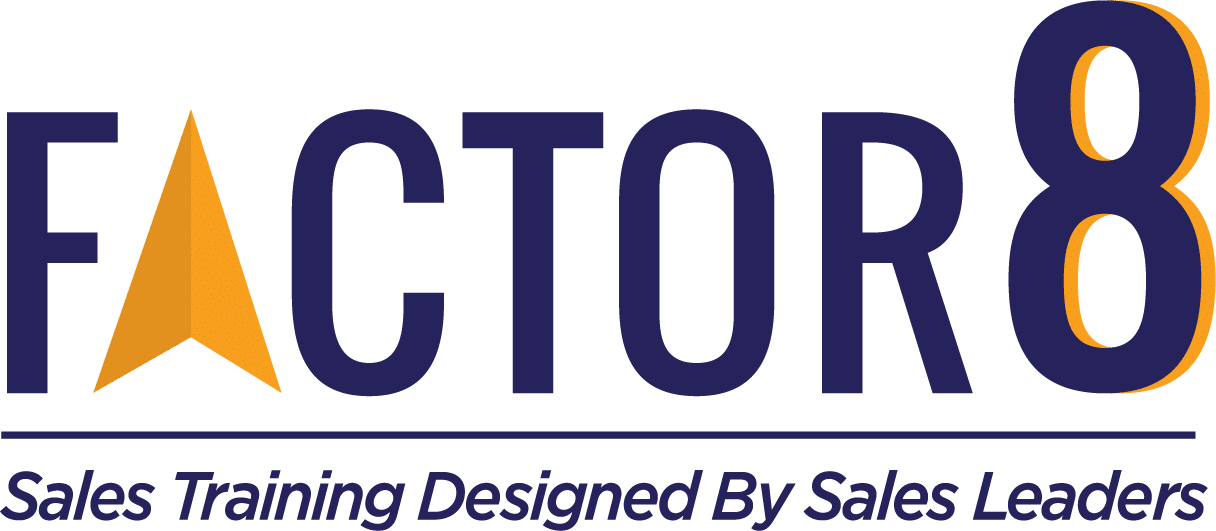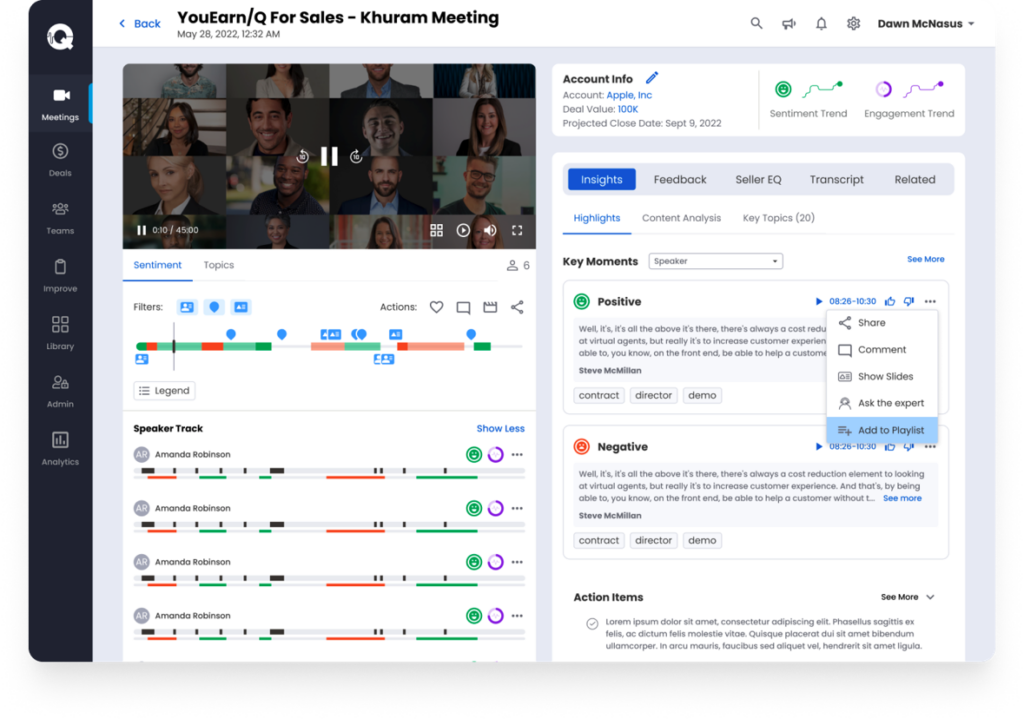How to Improve Buyer Engagement in Video Sales Meetings
There’s no denying that “something’s missing” when we move from in-person meetings to video. It’s true of team meetings, training, and especially sales calls. If video is part of your every day, how do you stand out from the crowd?
The baseline of video acumen has risen since the early days of remote work. You’ve got to go beyond the basics and use video as a tool in your arsenal. Thanks to technology, we can actually measure the effectiveness of our video meetings with AI tools.
How would you rate on a scale of 1 to 10 if we asked your prospects how engaging your sales call is?
What is Engagement vs. Sentiment?
When measuring the effectiveness of your sales calls, you’ve got to watch two things: engagement and sentiment.
For quick reference, here’s how we break down the two:
- Engagement = buyer’s attention or presence on the sales call
- Sentiment = buyer’s attitude or emotion towards the seller
According to Q for Sales, Uniphore’s AI-powered Sales Assistant, an engaged customer has an 83% higher propensity to buy than a non-engaged customer. When both engagement and sentiment are high, you’ve got an 89% greater chance of closing the sale.
DOWNLOAD: THE IMPACT OF BUYER ENGAGEMENT AND SENTIMENT ON DEAL OUTCOMES
TL;DR – Get them leaning in quickly, make sure they like you, and you’ve got nearly double the chances of closing the deal.
(Take a peek at Uniphore’s AI tool, Q for Sales, below to see how it tracks sentiment on video meetings.)
How Do You Engage Buyers (Faster)?
Nearly 29% of buyers admit to multitasking during video calls. That means that roughly one-third of buyers aren’t paying attention to you. It’s a lot harder to re-engage someone after they’ve already tuned out, so starting the call with a high level of engagement is key.
Follow these 8 steps to ensure engagement is high from the beginning of your call:
- Stop sharing your screen. Engagement goes down when sellers share their screens. Why? Because sellers ask fewer questions when they’re screen-sharing. We tend to go into a monologue and talk AT the buyer, vs. carry a conversation and ask questions. It’s not about the screen, but rather our behavior while the screen is up.
- Share personal information. Create a quick bond with a buyer by sharing something personal about yourself. It helps you find commonality and build quick rapport with the buyer.
- Review goals and the agenda. Start the call by outlining the goals and topics of discussion before diving in. Make sure you check in to see if the buyer wants to cover any other topics or has any other questions. This is especially important when selling to the C-suite. Give them the opportunity to drive the conversation by gauging what they want to cover on the call.
- Ask questions. As a general rule, the seller’s goal of the call should be to uncover as much important information as possible from the buyer. You do this by talking less and asking more questions.
- Ask them to recap their challenges. Even if they’ve told you what their challenges are before, you don’t want to put words in their mouth – it’s a surefire way to disengage them. Ask them to share their current situation and challenges.
- Match their energy. Imagine showing up to a sales call on a Monday morning after your 5th cup of coffee. The buyer shows up yawning and barely even awake. You want to lower your energy level to match theirs. If they’re pumped up and high-energy, match it. If they’re relaxed and calm, match it. It’s a form of empathy when you’re able to connect with buyer by matching their energy level to build trust and rapport.
- Say it with a smile. Positivity is contagious. Smiling automatically has a positive effect on your buyer’s sentiment. If you want to be easier to connect to, watch your facial expressions. Do you find yourself scowling without realizing it (read: RBF!)? Then practice smiling on all calls.
- Give them eye contact. It’s tough when you’ve got multiple screens with Slack, email, a presentation, and Zoom all open at the same time, but you’ve got to make sure you’re looking AT the camera and giving buyers eye contact. Tip: Put your notes underneath your camera so you can read from them while making eye contact.
How Do You Encourage A Buyer To Turn On Their Camera?
You ask them to turn it on. Easy, right? Yet 83% of sellers don’t do it. And, it’s so much harder to connect with someone when you can’t see them.
Need more of an incentive to ask? Let’s break it down with stats…
- Less than 10% of the message in a conversation is verbal
- Between 30-35% is in the tone, speed, or pitch
- But a whopping 50% of the conversation is visual (hello, body language)
So if you don’t ask them to turn on their camera, you’re missing more than half of the conversation.
If you need a little help asking them, try any of these out on your next sales call:
“Hey, if it’s not too forward, are you OK sharing your camera so we can talk face-to-face?”
“OK, camera bullying time! No hiding! Unless you’re literally naked, please pop it on. Thank you so so much. It’s hard talking to myself.”
“I promise I didn’t get dressed up for this meeting and there’s zero judgment! Would you mind terribly going on video so we can have some eye contact?”
How Can You Tell If A Buyer Is Engaged?
They’re showing signs of active listening and attentiveness by:
- Smiling
- Leaning forward
- Nodding
- Looking at their screen
- Showing their hands
- Chatting, clapping, sharing emojis, etc.
How Can You Tell When A Buyer Is Disengaged?
They’re actively not paying attention and are distracted by something else. If someone is disengaged, they might be:
- Looking away
- Leaning back
- Showing a negative facial expression
- Visibly reading their emails
- Playing on their phone
- Off camera
How Do You Quickly Reengage A Buyer?
- Notice or mention something that could be common ground – “I see that gorgeous picture in your background.”
- Share something first – “I am an avid sunrise photographer. Although, I don’t see them enough lately!”
- Ask a closed & follow-up question – “Did you take that yourself? It’s so beautiful! Where is it?”
- Ask an open question – “Tell me about it?”
TIP: TAKE OUR CLASS “AUTHENTIC (AND QUICK!) RAPPORT BUILDING”
You’ve got to master the art of active listening in order to effectively engage (or reengage) buyers.
Here’s how to be a great listener:
- Listen actively – No interrupting, look at the camera, nod your head
- Acknowledge – “Yes”, “Okay, got it”, “Mm-hmm”
- Restate (with empathy) – “OK, what I heard was that you’ve tried this many times already and it may be a little frustrating now.”
- Check-in – “Did I get that right?”
TIP: TAKE OUR CLASS “EXPERT AND EMPATHETIC LISTENING”
What Do You Do When A Buyer Disengages?
The first thing is to stop screen sharing. That way you can talk and pivot the conversation. Try some of these scripts to get your call back on track:
“I’ve been talking like 5 straight minutes, and I think I lost ya’ll. My bad. NAME, what’s the next most important thing we can cover for you?”
“Hey, I think I went off track. My bad. Let’s go back to the agenda. Is this still what you want to accomplish? Quick show of hands if you’d like to move on to XYZ item?”
“Let’s take a beat here to check-in. Could you please give me a thumbs up if you’re tracking with me 100% or a hand raise if you have a question? If I lost you completely, sit very still…”
TIP: TAKE OUR CLASS “DEMOS THAT DON’T SUCK”
How Do You Build Trust With Buyers?
Let’s talk about trust. According to Hubspot, only 3% of people trust salespeople.
“Trust is not something you can ask for, you need to earn trust. It takes hours, weeks, and years to build it, but seconds to lose it.” Sylvain Tremblay, CRO, Uniphore
Since trust is earned, that means we all start at the bottom of the trust scale, at mistrust. Luckily, we don’t start at distrust, that’s when someone knows us and has actively lost trust in us.
Mistrust means that they aren’t sure of our character based on the fact that we’re a salesperson and their fear that we’re going to try to force them to purchase their product.
Our job as salespeople, through empathy, engagement, and rapport building, is to move up the trust scale as fast as possible. Folks, you’ll never make it to the top of the trust scale in a call or two. It takes time to build trust. The goal is to simply move up the scale faster.

How Do You Build Rapport Quickly?
We’ve all heard that people buy from people they like, but the truth is that people buy from people that are LIKE them. We’re hard-wired to connect to people that are like us. That’s why small talk was invented; to help us find common ground with others.
The key to building authentic rapport (and quickly), is to let people get to know you faster.
Here are a few tips on what you can share with buyers to build rapport:
- Introduce yourself at the beginning of the call
- Get your resume off LinkedIn & share something about your experience
- Connect on LinkedIn with a personal message
- Send a personalized video
- Share some (personal) background
- Add something funny
- Make fun of yourself (pratfall effect)
If you want to connect to your buyer, you’ve got to give to get. Give information about yourself and you’ll get an authentic connection to your buyer.
Want more tips? Watch our 30-minute Sales Shot to learn how to improve buyer engagement in video sales meetings.


